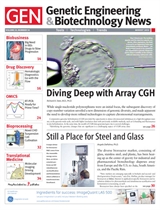Sep 9 2013
Biologists from the University of Texas Health Science Center at San Antonio reported yesterday that they have identified two pathways through which chromosomes are rearranged in mammalian cells. Their report, published in Nature, also noted that these types of changes are associated with some cancers and inherited disorders in people.
"Our finding provides a target to prevent these rearrangements, so we could conceivably prevent cancer in some high-risk people," said senior author Edward P. (Paul) Hasty, D.V.M.
The two pathways rearrange chromosomes by recombining DNA repeats, sections of DNA that are duplicated. Repeats are naturally found in the genome.
Both pathways are important for the synthesis of DNA. "Therefore, we propose that chromosomal rearrangements occur as DNA is being synthesized," Dr. Hasty said.
The experiments were conducted with mouse embryonic stem cells grown in tissue culture. The team measured the incidence of DNA repeats recombining in normal cells. This is called "repeat fusion." The scientists then looked for incidence of repeat fusion in cells affected by several genetic mutations.
In the paper, entitled, "Two replication fork maintenance pathways fuse inverted repeats to rearrange chromosomes," indicated that the spontaneously fused repeats generated unstable chromosomal rearrangements: "Gamma-radiation induced a [Bloom syndrome mutated]-regulated pathway that selectively fused identical, but not mismatched, repeats. By contrast, ultraviolet light induced a RAD18-dependent pathway that efficiently fused mismatched repeats."
These large, complicated rearrangements involved DNA repeats on multiple chromosomes. The discovery provides target to potentially halt the process, prevent cancers. "We hope the new findings will help us better understand the mechanisms that cause chromosomal instability, which causes some cancers in people," Dr. Hasty said.

 This article was reprinted from Genetic Engineering & Biotechnology News (GEN) with permission from Mary Ann Liebert, Inc., publishers. Genetic Engineering & Biotechnology News (GEN) has retained its position as the number one biotech publisher around the globe since its launch in 1981. GEN publishes a print edition 21 times a year and has additional exclusive editorial content online, like news and analysis as well as blogs, podcasts, webinars, polls, videos, and application notes. GEN's unique news and technology focus includes the entire bioproduct life cycle from early-stage R&D, to applied research including omics, biomarkers, as well as diagnostics, to bioprocessing and commercialization.
This article was reprinted from Genetic Engineering & Biotechnology News (GEN) with permission from Mary Ann Liebert, Inc., publishers. Genetic Engineering & Biotechnology News (GEN) has retained its position as the number one biotech publisher around the globe since its launch in 1981. GEN publishes a print edition 21 times a year and has additional exclusive editorial content online, like news and analysis as well as blogs, podcasts, webinars, polls, videos, and application notes. GEN's unique news and technology focus includes the entire bioproduct life cycle from early-stage R&D, to applied research including omics, biomarkers, as well as diagnostics, to bioprocessing and commercialization.